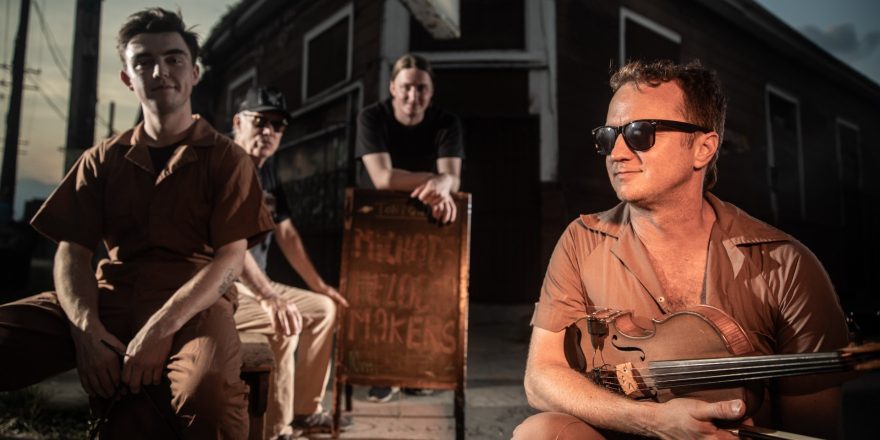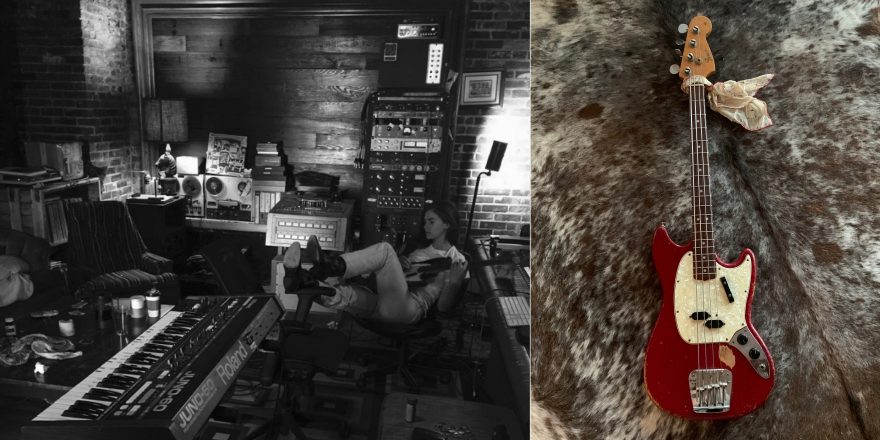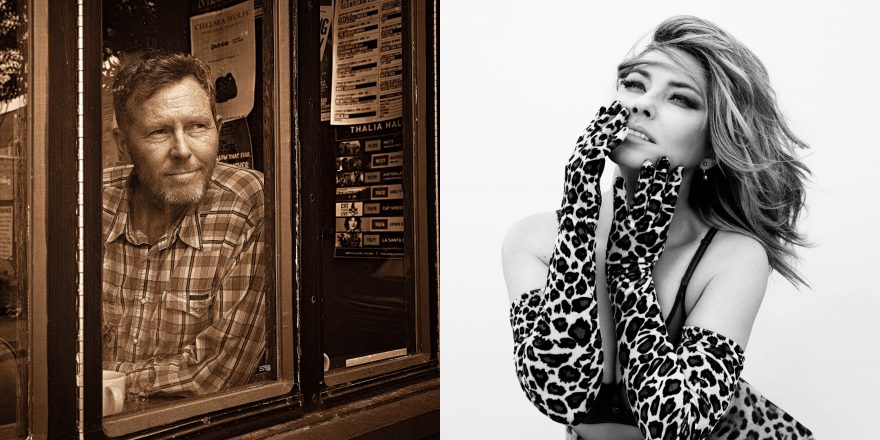In this age of renewed American nationalism, singing in the Louisiana French language is a practice in cultural diversity and tolerance. Cajun and Creole music are uniquely American art forms, the result of immigrants of diverse backgrounds building on each other’s experience and expression. Many people ask me what it is like to sing in this language to primarily anglophone audiences. My response is that I play an American music and sing in an American dialect: Louisiana French. There are hundreds of thousands of bilingual Louisianans and many more international francophones who understand the lyrics, but Louisiana French music has always managed to transcend cultural barriers.
I was raised speaking English, but French was spoken all around me. I never realized that there was the possibility to learn this language. To me, it was just how the older generations communicated. They’d often use it for private conversation among adults—often not even needing to leave the room. French was spoken by many of the teachers and custodians at school, customers and clerks at the local store, and family and acquaintances at our grandparents’ house.
I unknowingly grew up straddling a sort of cultural duality: a local Cajun French sphere, playing music with our family band, Les Frères Michot; and an anglophone, popular culture sphere that included writing psychedelic rock music with my friends from school. My brother Andre was my mentor in learning guitar, playing Jimi Hendrix and Led Zeppelin classics and going to blues jams at a young age. He was also the first of the younger generation to join Les Frères Michot as a professional guitar player, filling in for my Uncle Bobby while he was touring in France. I joined the family band a few years after Andre at the age of 15. Les Frères Michot gave us not only the chance to apprentice in Cajun music, but it also groomed many of the friends that we played with in other bands. Each of us would start out on triangle and work our way up to guitar or standup bass, which is still my primary instrument in the Michot family band.
For the first few years that I played French songs, I did not fully comprehend the lyrics or the song titles and what they meant. French was still an inactive part of my subconscious. It wasn’t until I turned 18 that I realized that this language was part of my cultural DNA. It was on the tip of my tongue and somehow ran in my blood. However, I couldn’t quite access it. Though I have a French name and many French ancestors, I’m just as American as anyone in Louisiana. I have a wide-canopied family tree that includes Creole Spanish, German, Irish, Jewish, Acadian, Belgian, and Sicilian. But the lingua franca that runs through much of my ancestry is Louisiana French. My family’s Spanish ancestors—colonial-era New Orleans diplomats —eventually changed their names and language to French, as did my Sicilian great-grandpa so as to integrate into the burgeoning Louisiana society.
When one first arrives in Acadiana in hopes to hear Louisiana French spoken, they may be surprised to find it more often sung. Music keeps the language alive and creates a space for it to flourish. Though it may just seem like a relic of centuries past, the Louisiana French language represents a people’s struggle to retain their identity and knowledge despite living in a “change your name and get rich overnight” American dream mentality.
French was the mother tongue for most of South Louisiana for hundreds of years and it is still spoken by approximately 200,000 Louisiana residents today. State-sponsored nationalist and Americanization programs of the 1920s outlawed any language other than English spoken in schools, and, as a result, generations of speakers of Cajun and Creole (now collectively known as “Louisiana French”) were compelled to see their own brilliant and unique tongue associated with the curse of poverty and an obsolete way of life. Through the decline and resurgence of French, it has still taken multiple generations to rediscover and value the cultural codes and history embedded in the words, terms, and characteristics of Louisiana French. We still have so much work to do.
My quest to become fluent in Louisiana French took me out of Louisiana to the Université Sainte-Anne in Nova Scotia, Canada for a five-week immersion program. This is the same land where my Acadian ancestors were forced out in 1755, many of whom ended up in Louisiana 10 years later. Describing the Acadian Expulsion (known as le Grand Dérangement) would require a much more thorough article, but know that it is a testament to the strength of Acadian culture and its influence on Louisiana Creole culture.
Traveling to Acadie for the first time was eye-opening, seeing a slice of my home state population where families of the same Louisiana names such as Sonnier, Thibodeaux, Leblanc, and Richard had been hiding out for 250 years and had not become part of the diverse spectrum of peoples that make up the modern Cajuns and Creoles of Louisiana. If you took a Boudreaux from Louisiana and removed the Spanish, German, and African from his DNA, all you’d be left with would be, well, an Acadian named Boudreau from Nova Scotia. This is the difference between an Acadian and a Cajun: hundreds of years of parallel evolution; but in Louisiana that genetic amalgamation would include the slaves and ex-slaves from the Caribbean and a whole slew of immigrants that did not exist in Nova Scotia.
In May of 1998, I arrived at Université Sainte-Anne barely knowing how to order a beer in French. In addition, I had to sign a contract to not speak any English for my five-week duration as an immersion student. It was as if I was given the chance to step back in time and learn the language of my ancestors, the same language that was denied to their children for the sake of American assimilation.
By the end of the session, I was finally thinking and even dreaming in French. I decided to continue the immersion on my own by hitchhiking across the Eastern provinces of Canada. Not only was I learning to speak French, I also brought my grandpa’s fiddle with me on the trip. I was learning to sing in French and play the hundreds of songs that were in my head from my years with Les Frères Michot. It was like fusing the cultural dualities of my life and art in ways that, until that point, I had never been able to access. Moreover, the ability to converse fluently in French—however elementary my skill at the time—was filling a distinct cultural void while inscribing a new raison d’etre.
I set out across Canada with my fiddle and a small backpack, carrying only a tent and sleeping bag. I walked to the shoulder of the road, stuck my thumb up, and waited for a ride. Not only did I get rides, almost everyone who picked me up helped me with my French. Strangers of the highway taught me new words and expressions, and politely corrected me when needed. In the two months that followed, I crossed Nova Scotia, Cape Breton, New Brunswick, Gaspésie, Quebec City, Montreal, and even as far as Toronto and Stroud, Ontario. Not once did I ever have to pay for a ride or a place to stay. People would welcome me into their homes or let me camp on their land. And if I had no other options, I’d sneak into the nearest patch of woods and pitch my tent until the morning. As each week went on, my French got better, as did my fiddle playing and singing. I felt like I was fully realizing myself, as I had never been a very good singer in my psychedelic rock bands. I had found my voice in Cajun French music, and the confidence I gained to speak French in those three months would change my life forever. When I returned to Louisiana, I was able to converse with French speakers in my family and community. Everything started making sense. Twenty years later I’m still learning new words and phrases every day.
Meanwhile, as I hitchhiked around Canada, my brother Andre had been practicing our father’s accordion back in Louisiana. We independently learned the lead instruments of Cajun music and first played together as Lost Bayou Ramblers in 1999. We started out with the same basic instrumentation as Les Frères Michot: fiddle, accordion, t-fer (triangle), acoustic guitar, and standup bass. But as the band grew in popularity and began releasing albums, it became apparent that our fan base was mostly young locals in New Orleans and Acadiana (the area of French Louisiana that is home to most of the state’s Francophone population), most of whom did not speak or understand French, but grew up with the language and music around them. Many of our fans grew up facing the same duality that we did with family members who spoke French and the “French Music” subconsciously embedded in their daily lives. When our band first began playing popular music venues (many of them atypical of the Cajun music scene) unsuspecting audiences would often be skeptical of us as we got on stage with an accordion and fiddle. But that apprehension quickly evaporated once we started playing a two-step rhythm with French vocals. The audiences were suddenly free to let their Cajun flags fly. Our music helped to bridge the gap between the music they liked and the music their grandparents always loved. Before long people were singing along to our songs in French. Regardless of whether or not they were fluent in the language, they connected with the lyrics, absorbing and learning them while belting them out along with us. It soon became apparent that our generation yearned for an updated version of the French Music, and the more we pushed our own musical boundaries, and that of the tradition, the more our South Louisiana crowds responded.
In the twenty years since starting Lost Bayou Ramblers, we have gone from an ultra-traditional band to a super-experimental and broad reaching outfit. But no matter how crazy we get on stage or on our recordings, the elements that never change are the accordion and fiddle driving the music, and French vocals.
Learning Louisiana French is a daunting task for any youth today, but it is possible. It requires becoming an apprentice to a guarded art, and an investigator of a seemingly secret code. And it undoubtedly requires gaining the trust of the elders in your family and community. It means being a relentless student and always responding in French to other speakers, even when your knowledge of the language is limited, and even when those who you seek as teachers have trouble breaking the habit of responding to younger generations in English. It means painstakingly deciphering local songs and familiarizing oneself with the lyric poetry that weaves words and expressions to fit the rhythm of a song. Some lines can take years to fully comprehend. It’s like a lifelong scavenger hunt in which some of the relics seem to have been buried under layers of midden, old ways of talking about the weather and working in the garden. And to make the quest even trickier, some of the words can’t even be found in ancient French texts as many of them were borrowed from Native American, English, Spanish, or African dialects.
Of all the unexpected outcomes from learning Louisiana French, the fact that my wife and I have supported our family through our work in the language continues to surprise us. La vie d’artiste has always been feast or famine and raising our three boys as artists has had its challenges. But our relationship with the language has always kept the struggle meaningful. My wife Ashlee has integrated the language into her personal and professional life whether it be as a French teacher, writer, artist and folklorist for her Prairie Des Femmes blog, or as a French announcer at Ville Platte, Louisiana radio station KVPI. Ashlee and I were first introduced in French, and have similar relationships with the language and culture. We both come from deep-rooted Louisiana families that within just a few generations have all but forgotten the first language of our near ancestors. We are invested in passing on what we’ve learned to our sons, and we hope that they will be part of a growing population of Louisiana French speakers.






